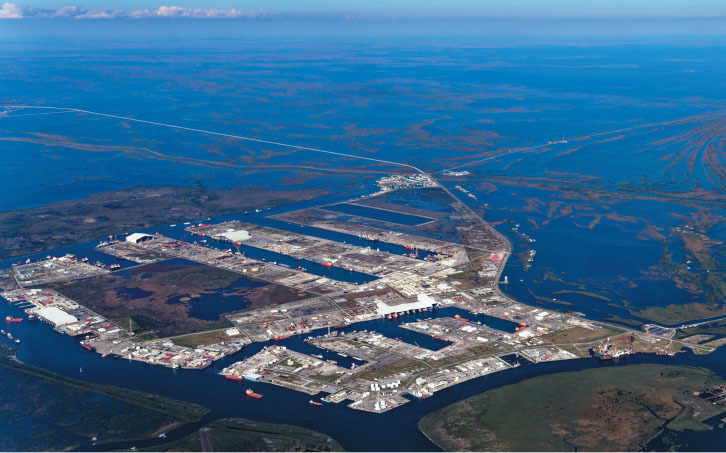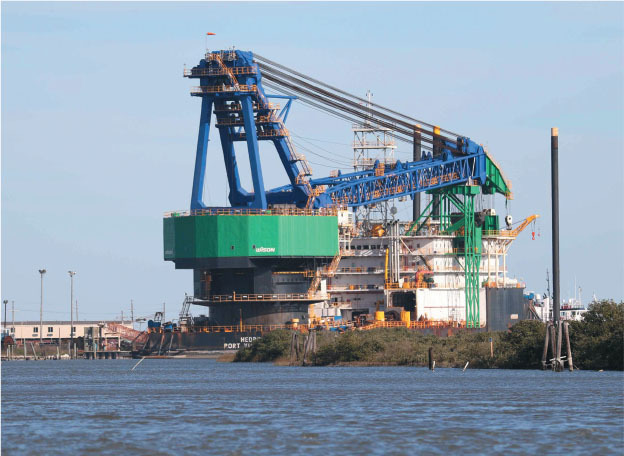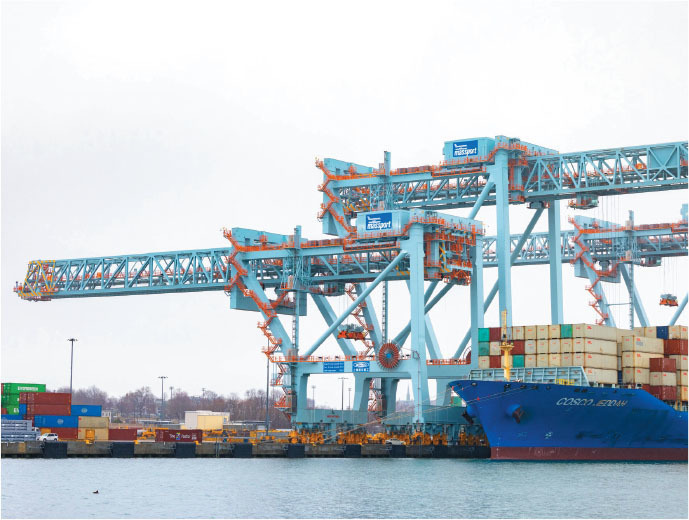
Big infrastructure upgrades are making ports more efficient, more competitive and greener
Corpus Christi, Texas, gets an average of 223 sunny days a year — compared with 205 for the average U.S. city — and the Port of Corpus Christi wants to harness that valuable resource.
Last August, the port’s commission approved a lease agreement with Buckeye Partners that will establish the first solar farm in the port’s 100-year history. The deal gave Buckeye two years to evaluate the feasibility of constructing the solar farm on 137 acres of port property. Buckeye owns a 112-acre parcel just north of that site, so the company has 249 acres to work with.
The 81,000-panel project will have the capacity to produce 88,000 megawatt hours of electricity per year — enough to, theoretically, power more than 15 million homes according to the Solar Energy Industries Association. The solar farm is tentatively scheduled to begin commercial operations in the fourth quarter of 2025, according to Jeff Pollack, the port’s chief strategy and sustainability officer.
That’s a sizeable project, but the Port of Corpus Christi has much larger plans for a 3,000-acre parcel that includes environmentally sensitive wetlands. The port is going through the permitting process with the U.S. Army Corps of Engineers to develop a solar farm there as well, and the port hopes “to have those permits in hand within the next six months,” Pollack said in April.

At that point, the port likely will request proposals from solar-farm developers. Early plans call for some wetland restoration and a “fairly elegant solution for how to make the most of the site while still upholding our commitment not to unduly impact sensitive habitat,” he added.
Electricity from that project could serve a variety of purposes, including boosting the resilience of Texas’s beleaguered power grid. According to Pollack, it also could power port operations, including electrolysis, the process of using electricity to split water molecules into hydrogen and oxygen atoms, thereby producing clean hydrogen fuel.
Currently, some hydrogen fuel is produced at the port using natural gas, but the solar installation would provide a zerocarbon alternative.
“Our market analysis indicates with very reasonable confidence that the demand for low-carbon, renewable electricity is high, and there certainly are paths to productive use of that electricity to help decarbonize local industry,” Pollack said. “There’s effectively an insatiable demand here for low-carbon electricity, and having some behind-the-meter access to renewable electricity is important.”
The Port of Corpus Christi is among a large group of AAPA member ports focusing on infrastructure upgrades to become more efficient, more competitive and greener. Here’s a snapshot of three other ports’ initiatives.
Branching Out at Port Fourchon
For decades, Port Fourchon has been the land base for companies servicing the offshore oil and natural gas industries in the Gulf of Mexico. Located in Cut Off, La., the port supports almost 100% of deep-water energy production in the Gulf, providing oil platforms with everything they need, including food, liquid mud, cement, and high-tech equipment such as underwater ROVs.
Now, Port Fourchon wants to play the same role for the offshore wind energy industry, and it took a major step toward that goal in February, announcing that Crowley intends to build an offshore wind terminal there. Through a deal with the port, Crowley gained the right of first refusal to build and operate the facility on more than 40 acres of mostly grassland at the port. The site features more than 2,200 linear feet of prime waterfront property.
Crowley — a logistics, marine and energy solutions provider based in Jacksonville, Fla. — is developing similar offshore wind terminals in Massachusetts and California. Otto Candies IV, business development specialist for Crowley Wind Services, said the company hopes to implement lessons learned from those projects in building out the Port Fourchon terminal.

In April, Candies said Crowley was reaching out to windfarm developers that could serve as “anchor tenants” for the terminal. The facility would provide some preassembly services for wind turbines and their foundations, then transport those components offshore, where a foreign-flag installation vessel would handle construction and installation.
Candies said Port Fourchon’s extensive experience supporting the offshore drilling industry makes it an ideal site for an offshore wind terminal. The facility would represent a step toward the stated goal of Louisiana Gov. John Bel Edwards to create five gigawatts of offshore wind power by 2035, he added.
“There’s been a lot of momentum for offshore wind power in Louisiana,” Candies said. “A lot of the operations that Port Fourchon is doing today really could benefit our potential customer base and end users at this site. There’s a supply chain in place from oil and gas operations that will be a huge advantage to our customers utilizing the facility and our assets.”
The offshore wind terminal would be an “energy addition” and not part of an “energy transition” for the port and the region, according to Chett Chiasson, executive director of the Greater Lafourche Port Commission. The country will continue to rely on oil and gas production in the Gulf for its growing energy needs, and offshore wind power will complement that production, he said.
“This is a big win for us because it shows that Port Fourchon is a full-service offshore-energy port facility,” Chiasson said. “We’ve been dominant over the last 25 years in servicing the offshore oil and natural gas industries, so that’s what we’ve been promoting to the offshore wind energy industry these past few years: We do this every day. It doesn’t matter if it’s wind turbines or drilling rigs and production platforms.”

Mission Complete at Port of Boston
The Port of Boston made news last November when the COSCO Shipping ALPS carrying 14,500 containers arrived from Asia, becoming the largest ship ever to dock in Boston Harbor. The ship’s arrival came two months after the Massachusetts Port Authority marked the completion of an $850 million modernization project that has significantly improved port operations, according to Lauren Gleason, Chief Administrative Officer for maritime at Massport.
Amid high inflation, $850 million doesn’t go as far as it used to, so the project’s completion last fall now seems especially well timed. Prior to the modernization, the Paul W. Conley Container Terminal offered two services reaching seven major global ports. Now, it has six services connecting shippers with 26 global ports, including China, Northern Europe, Southeast Asia, the Mediterranean, the Middle East and Latin America.
That expanded connectivity is “offering more opportunities than ever before for importers and exporters to compete in the global economy,” Gleason said, noting that more than 2,500 businesses ship and receive products through the port. Accordingly, the project included a new container yard that boosted Conley’s storage capacity by about 30%.
“It’s been a really rewarding journey,” Gleason said. “Those investments have proven to be successful, as proven by our expanded global reach and overall direct connectivity.”
A key component of the project involved dredging Boston Harbor to make it deep enough for the largest shipping vessels. In addition, the port installed three fully electric ship-to-shore cranes specially designed to be “low profile” due to the port’s location next to Boston Logan International Airport, Gleason said. The cranes measure 205 feet in height and can reach across 22 rows of containers, which is ample reach for the largest vessels calling on East Coast container ports today.

The electric cranes are in line with Massport’s goal of becoming Net Zero by 2031, the port authority’s 75th anniversary, and future projects will reflect that commitment, Gleason said. Other steps included installing LED yard lighting and power retrofits to rubber-tired gantry cranes to reduce energy consumption.
Shortening wait times for trucks has the dual benefits of reducing emissions and improving port operations, so the port plans to launch new gate technology and an online appointment system for trucks by the end of the year. The port also relocated its gate within the terminal so drivers would travel along a one-way, continuous loop, easing congestion, Gleason said.
Prior to the modernization project, trucks would drive through residential streets in South Boston on trips to and from the port. Now, however, trucks take advantage of a dedicated truck route called the Butler Freight Corridor, completed in 2017, to gain access to the highway system within minutes, Gleason said.
Calculating Costs at Port of Galveston
Inflation rates are indeed coming down, but not fast enough for port authorities planning infrastructure projects. In March, Rodger Rees, port director and chief executive of Galveston Wharves, said the board was considering issuing $100 million in bonds to fund “much-needed, time-sensitive projects” at the Port of Galveston.
After further evaluation, the board now plans to issue $120 million in bonds, Rees said in late April. “We’re looking to do a closing in August,” he said, noting that the proposal still needed approval from his board and the city of Galveston.
Funds would be used to expand the port’s West Port Cargo Complex, improve one of its three cruise terminals and construct a fourth one, Rees said. The port also expects to get money from the American Rescue Plan Act, allocated by the Texas Legislature. That funding would at least partially offset the $58 million in revenue that the port missed out on when COVID-19 forced a 15-month suspension of cruises.

One-third of the $120 million in proposed bonds would go toward improvements to Cruise Terminal 25 to accommodate the Carnival Jubilee. The ship is powered by liquid natural gas, making it a much greener vessel than traditional ships that use heavy fuel oil, Rees said. Carnival also is contributing to the project.
Few cruise ships currently run on LNG, and as such, the Port of Galveston lacks bunkering facilities for LNG-powered ships, but Rees is hoping to change that. He said the port has plans for a small LNG liquefaction plant on port-owned land on Pelican Island, which is part of Galveston. That facility would allow the port to refuel LNG-powered ships through a bunkering barge, Rees said.
“We believe there’s going to be an opportunity for our port to offer that service to ships,” he said.
The Port of Galveston generates 60% of its revenue from the cruise industry, but LNG refueling could bolster another key source of revenue: lay berthing, which Rees said represents a “huge opportunity” for the port.
On most days, a large group of vessels is waiting in line to dock at the Port of Houston, Rees said. To speed things up at one of the world’s largest ports, an increasing number of vessels now stop at the Port of Galveston to refuel, make crew changes or go through Coast Guard inspections. The port’s revenue from lay berthing totaled about $600,000 five years ago but swelled to about $6 million last year, with Rees expecting further growth.
“When the cruise ships aren’t here, we’re using those terminals for lay berthing,” Rees said. “Those ships want to get up to Houston and get out as quickly as possible because it’s crowded up there.”

Last fall, the Port of Galveston opened its third cruise terminal, a $125 million facility built by Royal Caribbean. The terminal measures about 160,000 square feet and generates its own electricity through rooftop solar panels. It can accommodate Oasis-class cruise ships, the largest currently on the water, capable of housing 6,500 guests. Construction involved driving approximately 700 piles anywhere from 60 to 100 feet into the ground, Rees said.
A fourth cruise terminal likely is a few years away, Rees said. The port plans to renovate a building currently used by a tenant to import fruit from South America and Central America, and the upgraded facility will house Norwegian Cruise Line and MSC Cruises.
“The cruise business is booming right now, and we’re basically the mid-America hub, so there’s demand for a fourth terminal,” Rees said.
The Port of Galveston’s cargo business includes imports such as BMW automobiles, farm equipment and components of wind turbines, along with exports such as fertilizer, grain, LNG and oil. Upgrading the West Port Cargo Complex will involve filling in slips that have become obsolete and replacing them with new berths, Rees said.
That project could lead to new tenants and opportunities for business, he added.
“With the supply chain issues, we’ve had a lot of inquiries from firms about coming in and operating our west end,” Rees said. “Galveston hasn’t typically been a container port; it’s pretty much all breakbulk. But now we have a couple of container companies that are interested in bringing containers here.”
 AAPA Seaports
AAPA Seaports


